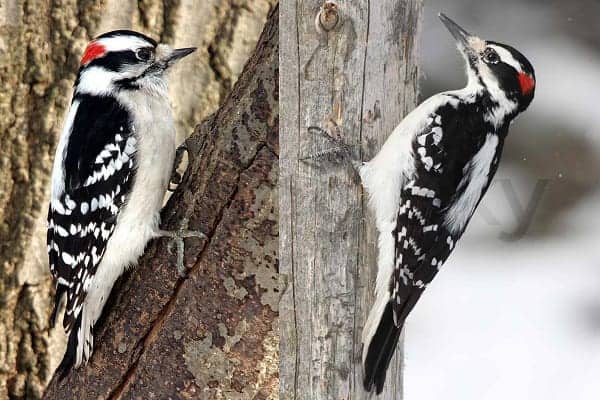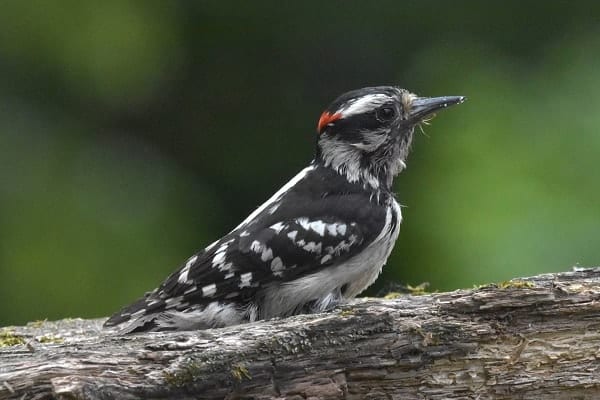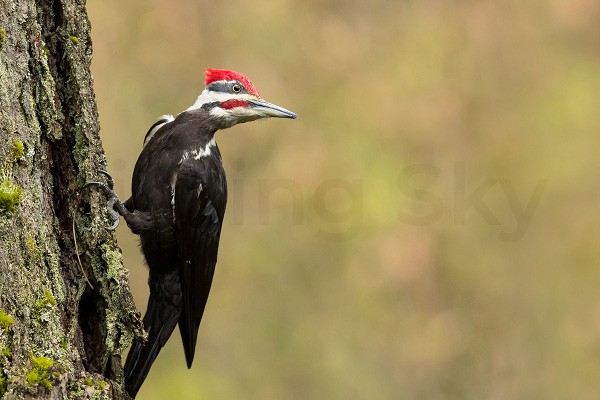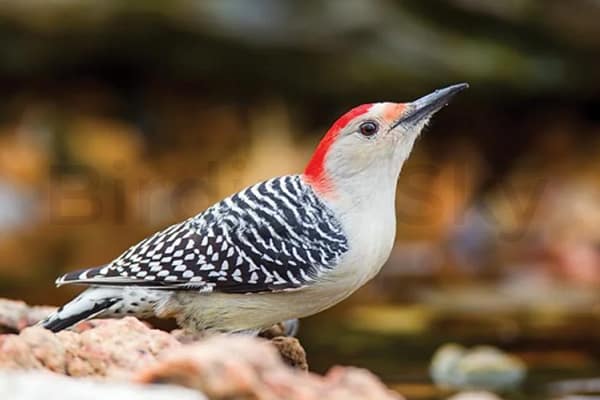Woodpeckers in Ohio are fascinating and diverse. They have colorful feathers, unique habits, and loud sounds. Ohio has seven kinds of woodpeckers, each with its own secrets. In this guide, you’ll learn about their habitats, food, calls, and nests. Whether you love birds, nature, or just want to know more, this is the place for you. Join me as we explore Ohio’s woodpecker world. You’ll be surprised by what you’ll find!
Here are the main points:
- Ohio is home to several woodpecker species, each with distinct characteristics.
- Learn to identify these birds with the help of pictures and information.
- Discover interesting facts about their behavior, habits, and unique markings.
- Uncover insights into their feeding preferences, nesting habits, and preferred habitats in Ohio.
- Explore the significance of woodpeckers in the local ecosystem and how they contribute to nature’s balance.
1. Hairy Woodpeckers
Hairy woodpeckers are a common sight in Ohio. These magnificent birds are known for their striking black and white plumage, with a white belly and black wings marked by white spots. They have a slightly larger size compared to other woodpeckers found in Ohio, such as the downy woodpecker.

To differentiate hairy woodpeckers from similar species, you can look for their iconic features. They have a long, sturdy bill that they use to chisel into tree bark in search of insects and larvae. You may also notice their distinctive crown, a red patch on the back of their head that adds a pop of color to their appearance.
Hairy woodpeckers are skilled foragers, primarily feeding on insects, nuts, seeds, and fruits. They can be found in various habitats, including forested areas and woodlands, where they use their strong bills to excavate nest cavities in dead or decaying trees.
When it comes to nesting, hairy woodpeckers are known to lay their eggs in these cavities, which they also use for roosting during the winter months. These cavities become crucial for other bird species and small mammals as well, who use them as shelter.
If you have the pleasure of spotting a hairy woodpecker in Ohio, take a moment to appreciate their beauty and the important role they play in the ecosystem. These birds not only contribute to the balance of insect populations but also add a touch of elegance to the natural surroundings.
2. Downy Woodpeckers
Downy woodpeckers are a common sight in Ohio. These small but mighty birds are part of the Picidae family and are known for their distinctive markings and interesting feeding techniques. Let’s take a closer look at these fascinating woodpeckers.

Habitat: Downy woodpeckers can be found in a variety of habitats throughout Ohio. They are commonly spotted in deciduous forests, woodlands, parks, and even urban areas. These adaptable birds can thrive in both rural and suburban environments.
Distinctive Markings: One of the key ways to identify Downy woodpeckers is through their distinct markings. They have black wings with white spots, a white underside, and a black-and-white striped head. The males also have a small red patch on the back of their heads.
Feeding Techniques: Downy woodpeckers use their strong beaks to drill into trees, searching for insects and larvae that live beneath the bark. They also have a unique feeding technique called “gleaning,” where they forage on leaves and stems for small insects and spiders. This agile feeding behavior sets them apart from other woodpecker species.
“Downy woodpeckers are known for their distinct markings and agile feeding techniques that help them survive and thrive in various habitats across Ohio.”
To help you visualize the unique features of Downy woodpeckers, here is a table summarizing their characteristics:
| Characteristic | Description |
|---|---|
| Size | Approximately 6.5 – 7 inches (16.5 – 17.8 cm) in length |
| Weight | Average weight ranges from 0.7 – 1.0 ounce (20 – 28 grams) |
| Coloration | Black wings with white spots, white underside, and a black-and-white striped head. Males have a small red patch on the back of their heads. |
| Feeding Behavior | Drills into trees for insects and larvae, and gleans on leaves and stems for small insects and spiders. |
3. Pileated Woodpeckers
Pileated woodpeckers are a remarkable species that can be found in the forests of Ohio. These majestic birds are known for their impressive size and striking appearance, making them a favorite among bird watchers and nature enthusiasts.

The pileated woodpecker is the largest woodpecker species in North America, measuring up to 19 inches in length with a wingspan of around 30 inches. With their vibrant red crest, black body, and white stripes on their face, these woodpeckers are easily distinguishable.
One of the most distinctive features of pileated woodpeckers is their loud drumming sounds. They use their powerful beaks to create resonating beats on dead trees, making their presence known and establishing their territories. This drumming behavior is not only a way of communication but also a means to attract mates.
When it comes to nesting, pileated woodpeckers prefer excavating cavities in large, mature trees. These cavities serve as their roosting and breeding sites and are often reused in subsequent years. These woodpeckers play an essential role in forest ecosystems by creating nesting cavities that are later used by other bird species and small mammals.
Interesting Facts about Pileated Woodpeckers:
- They have a long, sticky tongue that can extend up to 4 inches beyond their beak.
- Pileated woodpeckers primarily feed on ants and beetle larvae found in trees.
- They have exceptionally strong neck muscles that help them withstand the force of their powerful drumming.
- These woodpeckers require large areas of mature forest habitat to thrive.
- Pileated woodpeckers are known for their distinctive “kuk-kuk-kuk” calls, which can be heard echoing through the forest.
To get a better understanding of the characteristics, behavior, and habitat of pileated woodpeckers, refer to the table below:
| Characteristics | Behavior | Habitat |
|---|---|---|
| Large size (up to 19 inches long) | Drumming on trees to establish territories | Oak-hickory and mixed deciduous forests |
| Red crest, black body, and white facial stripes | Excavating large nesting cavities in mature trees | Areas with abundant dead trees for foraging and nesting |
| Powerful beak for drilling into tree bark | Feeding primarily on ants and beetle larvae | Forests with large, standing dead trees |
As you venture into Ohio’s forests, keep an eye out for these impressive pileated woodpeckers. Their size, vibrant colors, and distinct drumming will surely leave you in awe of their presence.
Also Visit Woodpeckers in Indiana
4. Red-bellied Woodpeckers in Ohio

Red-bellied woodpeckers are a common sight in Ohio. With their distinctive calls and vibrant plumage, they are a delight to observe in the wild. These woodpeckers have a unique red-headed appearance, which sets them apart from other species. Their foraging techniques are also fascinating to witness, as they use their strong beaks to search for insects and extract them from tree bark.
Red-bellied woodpeckers are adaptable birds and can be found in a variety of habitats, including woodlands, suburban areas, and parks. They are known to nest in cavities, often using old woodpecker holes or excavating their own in dead trees. These resourceful birds display interesting parenting habits, with both males and females sharing the responsibilities of incubating the eggs and feeding the young.
If you’re lucky enough to spot a red-bellied woodpecker in Ohio, take a moment to appreciate its vibrant colors and unique behaviors. These birds play an important role in the ecosystem by controlling insect populations and helping to maintain the health of trees in their habitat.
Must Read Woodpeckers In Tennessee
5. Yellow-bellied Sapsuckers
Yellow-bellied sapsuckers are migratory woodpeckers that grace the Ohio skies during certain times of the year. These captivating birds play an important role in the ecosystem as they create distinct sap wells on tree trunks, which not only provide them with a tasty meal but also attract other insects and birds to feed on the sap.

One of the fascinating features of yellow-bellied sapsuckers is their distinctive markings. With a black-and-white striped face and throat, a red crown, and a yellow belly, they are truly a sight to behold. These markings make them easily recognizable among their woodpecker relatives.
When it comes to habitats, yellow-bellied sapsuckers prefer mixed forests with a combination of coniferous and deciduous trees. They are often found in areas with abundant sap-producing trees such as birch and maple. These woodpeckers are also known to select specific trees for their sap wells, revisiting them repeatedly for their nourishment.
Yellow-bellied sapsuckers have a unique feeding habit. In addition to insects, they rely heavily on tree sap as a food source. By drilling rows of small holes in tree trunks, they create sap wells. As the sap oozes out, the sapsuckers use their specialized brush-like tongues to lap up the sweet liquid. This feeding behavior not only sustains the woodpeckers but also attracts other creatures to the sap wells, creating a miniature ecosystem in the process.
If you’re lucky enough to spot a yellow-bellied sapsucker during their visit to Ohio, take a moment to appreciate their role in nature’s delicate balance. These charming and resourceful birds bring life and activity to the forests they inhabit, leaving a mark both visually and ecologically.
| Yellow-bellied Sapsuckers | Quick Facts |
|---|---|
| Scientific Name | Sphyrapicus varius |
| Size | 7-8 inches in length |
| Coloring | Black and white striped face and throat |
| Preferred Habitats | Mixed forests with coniferous and deciduous trees |
| Feeding Habits | Drill sap wells on tree trunks and feed on insects |
| Migration Patterns | Migratory, seen in Ohio during certain times of the year |
You might be interested to read Woodpeckers in Arizona
6. Northern Flickers
Among the diverse woodpecker species in Ohio, the Northern Flickers stand out with their unique behaviors and striking appearance. These Ohio woodpeckers are known for their fascinating flight patterns, creating a distinctive flickering effect as they move through the air.

One of the most intriguing habits of Northern Flickers is their preference for foraging on the ground. They often hunt for ants and beetles, using their long, slightly curved bills to probe the soil in search of tasty insects. This ground-feeding behavior sets them apart from other woodpeckers and adds to their charm and versatility.
When it comes to their appearance, Northern Flickers showcase a beautiful range of plumage variations. The iconic markings on their backs, resembling bold chevrons, make them easily recognizable. Additionally, their undersides feature distinctive black spots, creating a captivating contrast against their pale feathers.
In Ohio, Northern Flickers typically choose tree cavities for nesting, which they excavate themselves. These woodpeckers have a strong preference for dead trees or snags, which provide the ideal habitat for their nesting needs. Keep an eye out for these fascinating birds as you explore Ohio’s woodlands and witness their flickering flight and distinctive calls.
Frequently Asked Questions
Q1: What is the rarest woodpecker in Ohio?
The Red-cockaded Woodpecker is considered one of the rarest woodpeckers in Ohio, although it is not a native species.
Q2: How many different woodpeckers are in Ohio?
Ohio is home to several woodpecker species, including the Pileated Woodpecker, Red-bellied Woodpecker, Downy Woodpecker, Hairy Woodpecker, and others.
Q3: What is the big red-headed woodpecker in Ohio?
The Red-headed Woodpecker is known for its distinctive red head and is present in Ohio.
Q4: Do woodpeckers stay in Ohio in the winter?
Yes, many woodpecker species stay in Ohio during the winter, adapting to the seasonal changes in their habitat.
